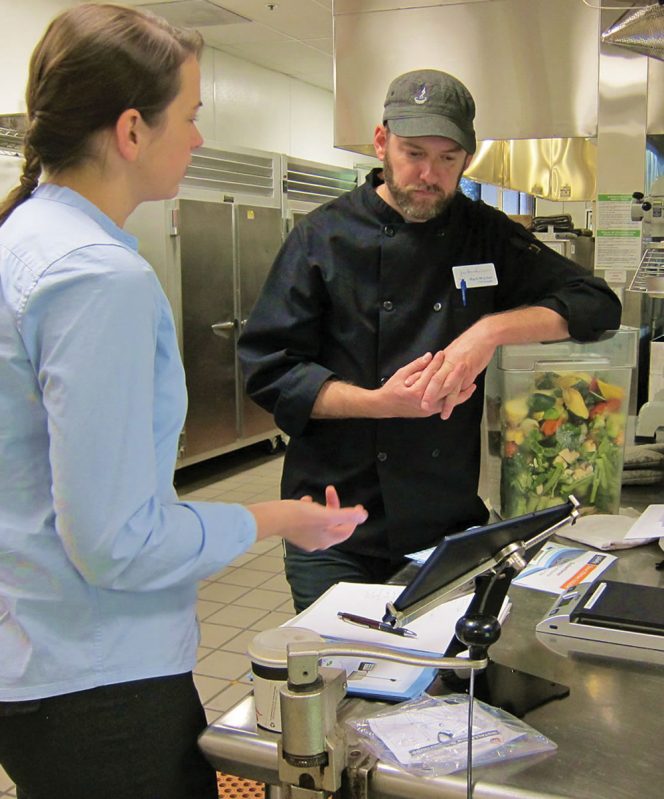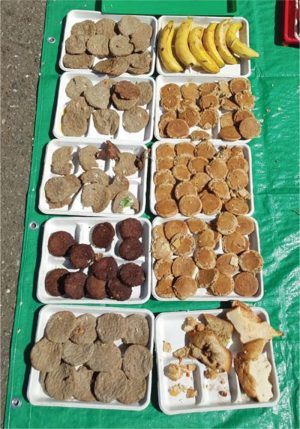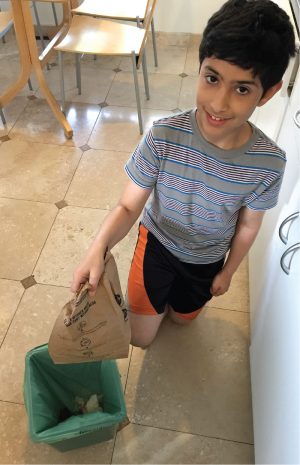StopWaste seeks to reduce food waste and increase donation in employee cafeterias and schools.
Marsha W. Johnston
BioCycle August 2016

Smart Kitchen Initiative participants include 13 employee cafeterias run by Guckenheimer, a corporate food service management firm. The cafeterias use the LeanPath monitoring system to track preconsumer food waste.
Still in Phase 1 of implementation, StopWaste’s Smart Kitchen Initiative (SKI) is a collaboration with LeanPath Inc., a food service technology company that markets a food waste monitoring system, to subsidize the cost of preconsumer food waste measurement and tracking systems for in-county food service providers, caterers and commercial kitchens with an annual food spend of $300,000 or more. SKI’s current participants include 13 employee cafeterias at companies such as Sybase, Clorox and the Pacific Research Center — run by Guckenheimer (provider of corporate food service management) — and two Spectra by Comcast Spectacor, provider of Food Services & Hospitality to Oakland-Alameda County Coliseum and the Alameda County Fairgrounds.
A major impetus underlying SKI is StopWaste’s 2020 county-wide goal to reduce the amount of readily recyclable or compostable materials in the trash stream to less than 10 percent. Currently, that amount is 45 percent for commercial waste and 35 percent for single-family households. The agency‘s implementation of a county-wide mandatory commercial recycling ordinance in 2012 — with specific rules regarding recycling and organics collection varying by city — is advancing the recovery of materials, but StopWaste opted to complement that with initiatives to prevent waste generation in the first place, and support donation of edible food when possible.
Recruitment And Implementation
When SKI was launched last fall, marketing and recruiting participants initially took some time, notes Cassie Bartholomew, the StopWaste Program Manager who leads the project: “People were interested, but we were offering a challenging proposition. Chefs would say, `You are asking me to measure food waste when we barely have enough time to cook.’” In the end, the savings potential and efficiency in tracking — effectively illustrated in an early case study at University of California Berkeley’s on-campus cafeterias — convinced the first cohort of SKI participants. “According to LeanPath, on average, 4 to 10 percent of the food a food service provider purchases is thrown out before it reaches a plate,” explains Bartholomew. “With a food spend of, say, $500,000, it adds up to a $20,000 to $50,000 loss — that’s significant.” Considering that Alameda County has over 5,200 food service operators, the project has the potential to keep a lot of food waste out of landfills, and also help local businesses economically, not to mention the environmental and social benefits of reducing wasted food.
SKI participants are asked to measure only preconsumer food waste (“kitchen waste”), which comprises trim such as vegetable and fruit peels; spoiled and expired foods, including prepared food items that have sat out too long without heating or cooling to be safe; items that arrived spoiled from the food supplier; and over-produced items not served. Postconsumer food waste (“plate waste”) is not included.
For the first year of SKI participation, StopWaste absorbs the full cost of a LeanPath Food Waste Tracking System, including software, equipment, technical assistance and coaching — a value ranging from approximately $4,500 to $10,000, depending on the tracker model and level of coaching. Food service operators with a smaller food budget are set up with a tablet-only system Zap Connect, while larger scale kitchens get the LeanPath 360 Tracker 2.0 system that includes a scale, tablet and a camera.
Bartholomew describes how the system works: “By consistently tracking the type and weight of preconsumer food waste generated during preparation, along with the reason it became waste, SKI participants establish a baseline of preconsumer food waste. They then review the tracking data to identify patterns and use the results to adjust kitchen routines such as food prep, ordering, and production that help eliminate recurring types of food waste.” Per their agreement with StopWaste, participants aim to reduce food waste by 25 percent from that established baseline. Bartholomew adds that although LeanPath believed participants could reduce their waste by as much as 50 percent, the agency chose a more conservative initial target.
To help evaluate progress, the LeanPath system generates weekly reports using the data logged and emails them to each site’s designated program lead (or “champion” in SKI terminology). Bartholomew receives a high level report that combines results from all participating sites. Since the start of the project, the 15 SKI participants have logged 10,878 food waste transactions, recording 70,107 pounds of food waste valued at $44,077. All of the current Phase I SKI participants have exceeded their 25 percent baseline reduction goal within the first six months of participation.
Phase 1 Lessons
Working with participants from the same company — as is the case with the 13 Guckenheimer sites and two Spectra by Comcast Spectacor locations — has had advantages. First, a certain economy of scale enabled StopWaste to bring more sites on board than had each been managed separately. Second, using large food service accounts within the same company made it easier to communicate the benefits of food waste tracking, and thus facilitate its adoption throughout the organization. For example, sites are more likely to attend and engage in recurring SKI “peer coaching calls” when all participants are from the same company. As each site’s results are reviewed and best practices shared, colleagues learn from each other and stay motivated, especially if management supports the initiative, as is the case with Guckenheimer. During one recent call, the group discussed soup — a typical food waste item in employee cafeterias. “Practices shared ranged from giving out free sides of soup after a certain time to selling quarts of soup to employees,” notes Bartholomew. “I don’t think the conversation would happen this way if the sites weren’t all Guckenheimer.”
Building on these successes, StopWaste intends to continue the “Guckenheimer” model into the second year of SKI, looking to continue working with existing kitchens to start or expand food donation programs for surplus food and recruiting new sites, targeting corporate kitchens, health care, institutions and assisted living. “Ultimately, we’re looking for sites where there’s initial buy-in from corporate or executive level staff,” she adds.
Boost To Food Donation
The exchange of ideas triggered by SKI between the public and private sector has also been fruitful. For example, the collaboration between StopWaste and LeanPath spurred modifications to the food waste tracking system that further advance the potential for food donation among food service providers. Bartholomew explains that initially, the system allowed participants to select “donation” as a destination for a wasted food item if it had indeed been donated, but had no way to indicate whether food was eligible for donation, but had instead been composted or landfilled. At StopWaste’s request, LeanPath added that option to the system — now enabling sites to gauge the amount of food suitable for donation, even before they establish a donation program. Bartholomew is excited about the new capability: “If we are able to show sites how much edible food they could have donated in a given week or month, and connect them with a local food recovery organization willing to pick up the surplus food, the likeliness of the company agreeing to an ongoing food donation effort is increased.”

Students conducted an audit (left) after “Breakfast for Lunch” day and found a lot of waste. They were planning to present this data to nutrition services.
To reach consumers about food waste prevention, StopWaste is planning to build on and tie in with the recently launched nationwide “Save The Food” campaign by the Ad Council and Natural Resources Defense Council (NRDC). StopWaste is considering integrating messages about preventing food waste with its existing Ready Set Recycle call to action for consumers to compost their food scraps. “This would be something like `Prevent, then Compost the rest,’” explains Bartholomew. “You don’t often see these two things combined because they require different behaviors.”
Outreach At Schools
Further aiding the agency’s outreach is StopWaste’s food waste reduction programs in some of the 17 school districts in Alameda County. These include district-level food waste reduction and food share and donation partnerships with the Oakland Unified School District (OUSD) and the Livermore Valley Joint Unified School District (LVJUSD), as well as new organics diversion (composting) programs at other schools.
Early conversations about testing LeanPath food waste tracking systems in the OUSD district did not result in implementation. “We were told that the learning curve for using LeanPath technology is just too high for school cafeterias and that there is more opportunity in tackling postconsumer than preconsumer waste,” explains Bartholomew. Instead, OUSD piloted the EPA’s Wasted Food and Packaging manual tracker using paper logs in the back of the kitchen. As a result, OUSD has included additional metrics in its Daily Production Sheets, adding a “why food was lost” column that provides feedback to kitchen managers to adjust their operations. In addition, OUSD received a grant from StopWaste in 2013 to pilot a food donation and food share program, which it has expanded.
This year, StopWaste partnered with Nancy Deming, a K-12 Schools Sustainability Specialist, and LVJUSD to support waste sorting stations in the kitchen and cafeteria. The program was funded through an Altamont Education Advisory Board grant and had staff support from StopWaste. The cafeteria station includes a Food Share area where students may leave or take uneaten, unopened food as well as fruit and vegetables. After the lunch period, nonperishable items such as crackers and fruit go back to the kitchen to be repurposed. “The launch party for Livermore’s cafeteria and kitchen sorting program was attended by 60 nutrition services and kitchen staff and included a screening of the film ‘Just Eat It,’ explains Bartholomew. “Livermore’s next step will be to implement district-wide Food Share and explore a food donation program.”

Oceanview Elementary in Albany (CA) participated in StopWaste’s 4Rs Student Action Project on wasted food prevention. Sajaad Soufiani, a 5th grader in Judith Sinclair’s class at Oceanview, places a compostable bag filled with wasted food into a compost pail at home.
For example, this past school year, 4RsSAP partnered with San Lorenzo Unified School District’s (SLZUSD) Recycling Committee, which includes the District’s staff and Operations Manager, the Oro Loma Sanitary District, Waste Management and Green Facilitators, to organize organics recycling in six cafeterias. “According to our custodians, the average eight bags of cafeteria landfill waste a day has been reduced to less than two bags a day after introducing sorting for recyclables and organics,” notes Vergara. “When you look into the organics recycling bags after lunch, a good percentage is wasted food. SLZUSD has just come on as a priority school district partner, and is committed to looking for solutions to reduce waste, including food waste.”
Student Engagement
Working directly with individual teachers and their students also brings school-wide results. After starting with traditional recycling in a 5th grade classroom at Mission San Jose Elementary (MSJE) in the Fremont Unified School District, StopWaste provided the school with a mini grant to implement a student-led classroom recycling program. Subsequently, the City of Fremont said the school qualified for free organics recycling service because the students proved they could lead their school in waste reduction. The class also arranged to take surplus cafeteria food to a local shelter, which has been sustained by the Parents’ Green Team.
MSJE also participated in StopWaste’s Food Too Good To Waste (FTGTW) Student Action Project curriculum (adapted from the EPA’s FTGTW Toolkit). The FTGTW Student Action Project, explains Vergara, is “a teaching and learning model where students investigate waste issues in school and at home, do waste audits, and through collaborative discussions, using their waste audit findings, determine what students can do to engage their peers and families in stopping waste.”
Getting students engaged, she adds, provides StopWaste with pertinent, on-the-ground information it can take to the district. “We can really leverage authentic work of the students to make change and solve problems at the district level,” notes Vergara. For example, in one program, students surveyed fellow students about what they want to eat at school, and received comments about the food not reflecting the cultural tastes of a lot of kids. Another finding was that the “Breakfast for Lunch” day has a lot of waste, which students plan to present to nutrition services. “Students are making an impact by tackling food waste prevention at school, at home, and in their community,” she adds. “It’s exciting to see our youth become part of the solution, taking action now.”
Marsha Johnston, editor of Earth Steward Associates, is a Contributing Editor to BioCycle.










